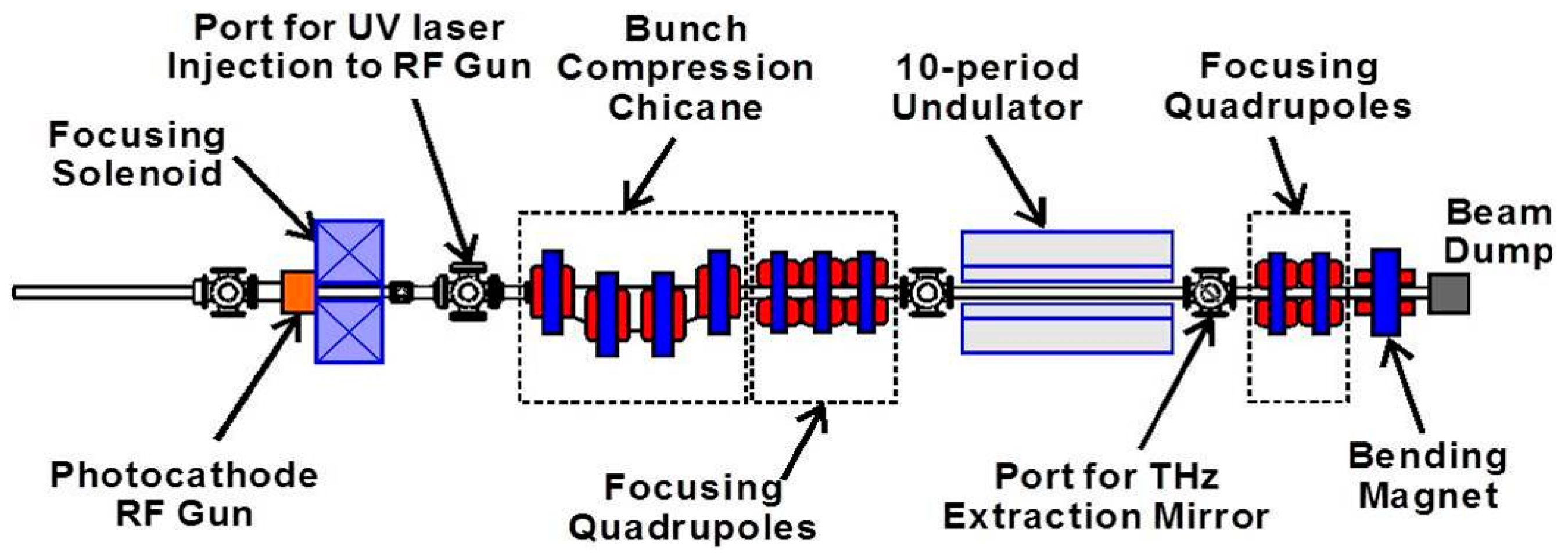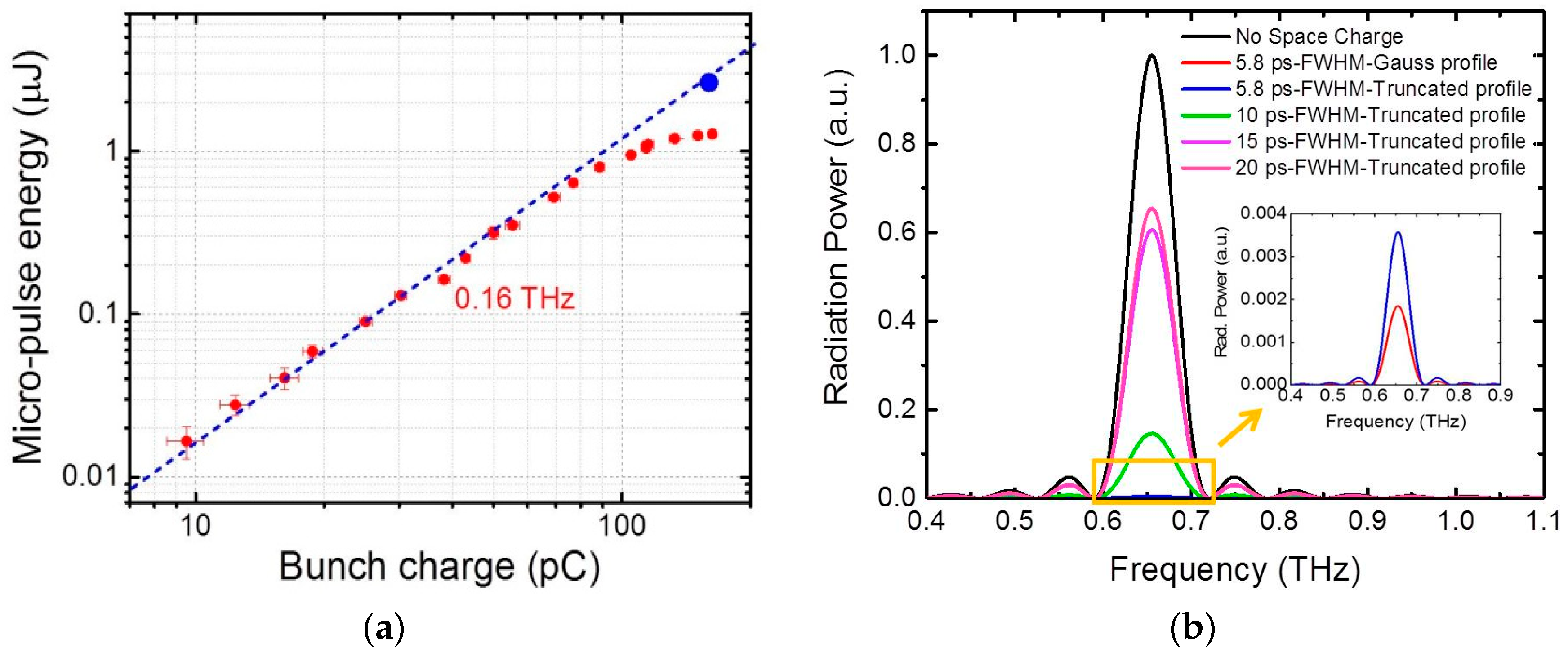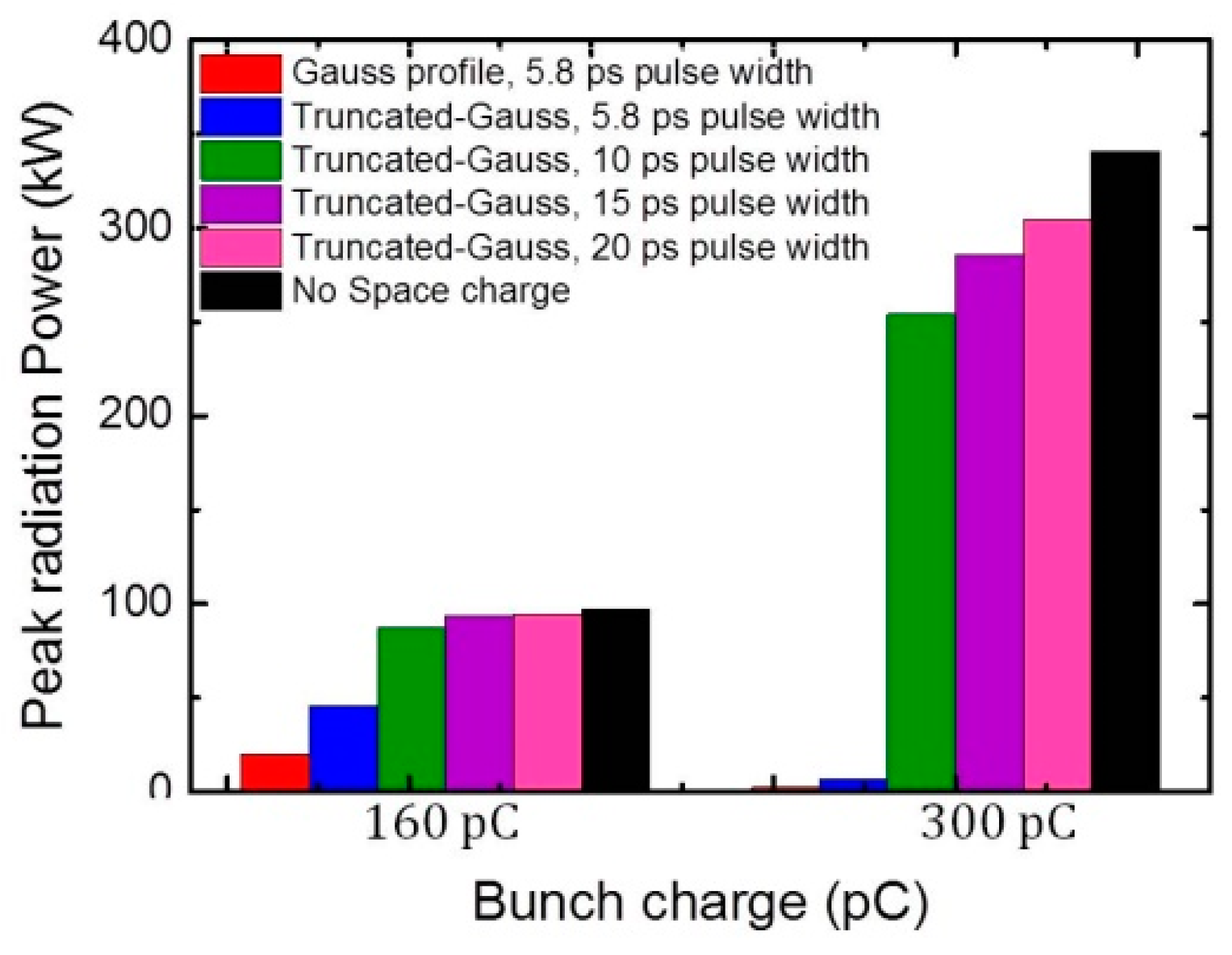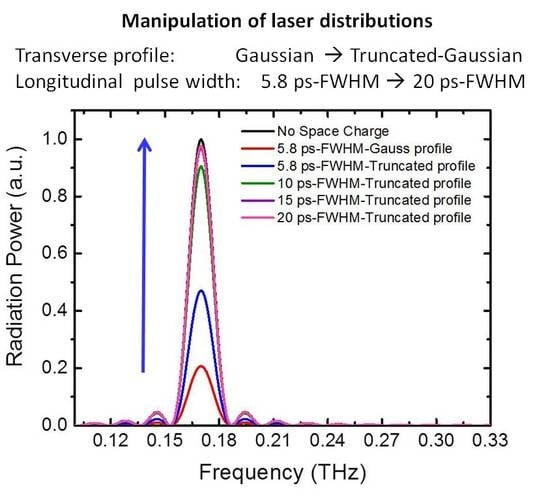Manipulation of Laser Distribution to Mitigate the Space-Charge Effect for Improving the Performance of a THz Coherent Undulator Radiation Source
Abstract
:1. Introduction
2. Space-Charge Effect
2.1. Longitudinal Phase Space before Compression
2.2. Bunch Compression with Negative R56 Chicane
3. Manipulation of Laser Distribution
- Transverse laser profile: The transverse truncated Gaussian profile can be modified by clipping the drive laser of the Gaussian profile with an aperture before irradiation. The laser spatial distribution has to be cut at the center, as shown in Figure 5a.
- 2.
- Laser pulse width: The laser pulse width was enlarged from 5.8 ps-FWHM to 10 ps-FWHM, 15 ps-FWHM, and 20 ps-FWHM with Gaussian distribution as plotted in Figure 7. Since the laser pulse width can be defined as the initial length of the electron bunch, the longitudinal bunch can be deformed more easily by the shorter bunch length owing to a stronger space-charge effect in the longitudinal direction. Due to the charge density of the electron bunch also being determined by the laser pulse width on the cathode, the expanding of the pulse width would have a low effect on electron beam dynamics as well. In practice, the longer laser pulse width can be provided by using the pulse stacking system reported in Ref. [26].
4. Results and Discussion
4.1. Longitudinal Particle Distribution
4.2. Electron Bunch Length
4.3. Improvement of the THz-CUR Performance
4.4. Expected Radiation Power of the THz-CUR at 0.16 THz
5. Conclusions
Author Contributions
Funding
Conflicts of Interest
References
- Dhillon, S.S.; Vitiello, M.S.; Linfield, E.H.; Davies, A.G.; Hoffmann, M.C.; Booske, J.; Paoloni, C.; Gensch, M.; Weightman, P.; Williams, G.P. The 2017 terahertz science and technology roadmap. J. Phys. D Appl. Phys. 2017, 50, 043001. [Google Scholar] [CrossRef] [Green Version]
- Davies, A.G.; Linfield, E.H.; Johnston, M.B. The development of terahertz sources and their applications. Phys. Med. Biol. 2002, 47, 3679–3689. [Google Scholar] [CrossRef] [PubMed]
- Hafez, H.A.; Chai, X.; Ibrahim, A.; Monda, S.; Férachou, D.; Ropagno, X.; Ozaki, T. Intense terahertz radiation and their applications. J. Opt. 2016, 18, 093004. [Google Scholar] [CrossRef] [Green Version]
- Tanaka, K.; Hirori, H.; Nagai, M. THz Nonlinear spectroscopy of solids. IEEE Trans. Terahertz Sci. Technol. 2011, 1, 301–312. [Google Scholar] [CrossRef]
- Vicario, C.; Ovchinnikov, A.O.; Chefanov, O.V.; Hauri, C.P. Multi-Octave Spectrally Tunable Strong-Field Terahertz Laser. 2016. Available online: https://arxiv.org/abs/1608.05319 (accessed on 4 October 2018).
- Minamide, H. Development of high-power terahertz-wave sources for finding novel applications. IEEE Trans. Terahertz Sci. Technol. 2015, 5, 1104–1109. [Google Scholar]
- Krishnagopal, S.; Kumar, V.; Maiti, S.; Prabhu, S.S.; Sarkar, S.K. Free electron laser. Curr. Sci. 2004, 87, 1066–1078. [Google Scholar] [CrossRef]
- Kim, K.J.; Sessler, A. Free-electron lasers: Present status and future prospects. Science 1990, 250, 88–93. [Google Scholar] [CrossRef] [PubMed]
- Seo, Y.H.; Lee, W.H. Superradiant undulator radiation of periodic intense electron bunches in a cavity. IEEE Trans. Plasma Sci. 2010, 38, 2016–2020. [Google Scholar] [CrossRef]
- Tan, P.; Huang, J.; Liu, K.; Xiong, Y.; Fan, M. Terahertz radiation sources based on free electron lasers and their applications. Sci. China Inf. Sci. 2012, 55, 1–15. [Google Scholar] [CrossRef]
- Sikharin, S.; Tsugamura, Y.; Zen, H.; Kii, T.; Ohgaki, H. Development of compact TH-FEL system at Kyoto University. In Proceedings of the FEL Conference, Basel, Switzerland, 25–29 August 2014; pp. 501–504. [Google Scholar]
- Kovalev, S.; Wang, Z.; Deinert, J.C.; Awari, N.; Chen, M.; Green, B.; Germanskiy, S.; Oliveira, T.V.A.G.; Lee, J.S.; Deac, A. Selective THz control of magnetic order: New opportunities from superradiant undulator sources. J. Phys. D Appl. Phys. 2018, 51, 114007. [Google Scholar] [CrossRef]
- Kampfrath, T.; Sell, A.; Klatt, G.; Pashkin, A.; Mährlein, S.; Dekorsy, T.; Wolf, M.; Fiebig, M.; Leitenstorfer, A.; Huber, R. Coherent terahertz control of antiferromagnetic spin waves. Nat. Photonics 2011, 5, 31–34. [Google Scholar] [CrossRef]
- Baierl, S.; Mentink, J.H.; Hohenleutner, M.; Braun, L.; Do, T.M.; Lange, C.; Sell, A.; Fiebig, M.; Woltersdorf, G.; Kampfrath, T.; et al. Terahertz-driven nonlinear spin response of antiferromagnetic nickel oxide. Phys. Rev. Lett. 2016, 117, 107201. [Google Scholar] [CrossRef] [PubMed]
- Zen, H.; Suphakul, S.; Kii, T.; Ohgaki, H.; Kuroda, R.; Taira, Y. Development of photocathode drive laser system for RF guns in KU-FEL. In Proceedings of the FEL Conference, Basel, Switzerland, 25–29 August 2014; pp. 828–831. [Google Scholar]
- Krainara, S.; Zen, H.; Suphakul, S.; Kii, T.; Ohgaki, H. THz coherent undulator radiation generated from compact accelerator based on photocathode rf gun. In Proceedings of the PASJ Conference, Sapporo, Japan, 1–3 August 2017; pp. 118–121. [Google Scholar]
- Krainara, S.; Zen, H.; Suphakul, S.; Kii, T.; Ohgaki, H. Development of compact THz coherent undulator radiation source at Kyoto University. In Proceedings of the FEL Conference, Santa Fe, NM, USA, 20–25 August 2017; pp. 158–161. [Google Scholar]
- Krainara, S.; Zen, H.; Shuya, C.; Kii, T.; Ohgaki, H. Study of the saturation of radiation energy caused by the space charge effect in a compact THz coherent radiation source. J. Phys. Conf. Ser. 2018, 1067, 032022. [Google Scholar] [CrossRef]
- Pencoa, G.; Allariaa, E.; Badanoa, L.; Cinquegranaa, P.; Craievichb, P.; Danailova, M.; Demidovicha, A.; Ivanova, R.; Lutmanc, A.; Rumiza, L.; et al. Optimization of a high brightness photoinjector for a seeded FEL facility. J. Instrum. 2013, 8, P05015. [Google Scholar] [CrossRef]
- Harkay, K.C.; Li, Y.; Nemeth, K.; Rosenberg, R.A.; White, M.; Spentzouris, L.K. Photocathode studies for ultra-low-emittance electron sources. In Proceedings of the PAC Conference, Vancouver, BC, Canada, 4–8 May 2009; pp. 458–460. [Google Scholar]
- Togawa, K.; Shintake, T.; Inagaki, T.; Onoe, K.; Tanaka, T.; Baba, H.; Matsumoto, H. CeB6 electron gun for low-emittance injector. Phys. Rev. ST Accel. Beams 2007, 10, 020703. [Google Scholar] [CrossRef]
- Akre, R.; Dowell, D.; Emma, P.; Frisch, J.; Gilevich, S.; Hays, G.; Hering, P.; Iverson, R.; Limborg-Deprey, C.; Loos, H.; et al. Commissioning the Linac Coherent Light Source injector. Phys. Rev. ST Accel. Beams 2008, 11, 030703. [Google Scholar] [CrossRef]
- Beaudoin, B.L.; Thangaraj, J.C.T.; Edstrom, D., Jr.; Ruan, J.; Lumpkin, A.H.; Broemmelsiek, D.; Carlson, K.A.; Crawford, D.J.; Romanov, A.; Santucci, J.K.; et al. Longitudinal bunch shaping of picosecond high-charge MeV electron beams. Phys. Plasmas 2016, 23, 103107. [Google Scholar] [CrossRef]
- Hyun, K.; Yim, C.M.; Parc, Y.W.; Park, J.H.; Ko, I.S.; Kim, C.; Park, J. Longitudinal laser pulse shaping for low-emittance electron-beam generation. J. Korean Phys. Soc. 2009, 54, 381–385. [Google Scholar] [CrossRef]
- Yang, J.; Sakai, F.; Yanagida, T.; Yorozu, M.; Okada, Y.; Takasago, K.; Endo, A.; Yada, A.; Washio, M. Low-emittance electron-beam generation with laser pulse shaping in photocathode radio-frequency gun. J. Appl. Phys. 2002, 92, 1608. [Google Scholar] [CrossRef]
- Kim, C.; Park, J.; Hyun, K.; Yim, C.M.; Parc, Y.W.; Ko, I.S. Laser pulse shaping for generation of low-emittance electron beam. In Proceedings of the FEL Conference, Gyeongju, Korea, 24–29 August 2008; pp. 278–281. [Google Scholar]
- Zhou, F.; Brachmann, A.; Emma, P.; Gilevich, S.; Huang, Z. Impact of the laser spatial distribution on the LCLS photocathode gun operation. Phys. Rev. ST Accel. Beams 2012, 15, 090701. [Google Scholar] [CrossRef]
- Li, W.W.; Huang, R.X.; He, Z.G.; Jia, Q.K.; Zhou, G.Q. Generation and measurement of sub-picosecond electron bunch in photocathode RF gun. In Proceedings of the IPAC Conference, Shanghai, China, 12–17 May 2013; pp. 372–374. [Google Scholar]
- Miyajima, T.; Honda, Y.; Yamamoto, M.; Uchiyama, T.; Harada, K.; Shimada, M.; Takai, R.; Kume, T.; Nagahashi, S.; Obina, T.; et al. Low emittance electron beam transportation in compact ERL injector. In Proceedings of the IPAC Conference, Dresden, Germany, 15–20 June 2014; pp. 3104–3106. [Google Scholar]
- Travier, C. An introduction to photo-injector design. Nucl. Instrum. Methods A 1994, 340, 26–39. [Google Scholar] [CrossRef]
- Kim, K.J. RF and space-charge effects in laser-driven rf electron guns. Nucl. Instrum. Methods A 1989, 275, 201–218. [Google Scholar] [CrossRef]
- Stupakov, G.; Huang, Z. Space charge effect in an accelerated beam. Phys. Rev. ST Accel. Beams 2008, 11, 014401. [Google Scholar] [CrossRef]
- Van der Geer, S.B.; de Loos, M.J. General Particle Tracer: A 3D code for accelerator and beam line design. In Proceedings of the EPAC Conference, Barcelona, Spain, 10–14 June 1996; pp. 1245–1247. [Google Scholar]
- Wang, X.J.; Chang, X. Femto-seconds kilo-ampere electron beam generation. Nucl. Instrum. Methods A 2003, 507, 310–313. [Google Scholar] [CrossRef]
- Wang, X.J.; Ben-Zvi, I. Longitudinal emittance compensation in a photocathode RF gun injector. In Proceedings of the PAC Conference, Vancouver, BC, Canada, 12–16 May 1997; p. 6259326. [Google Scholar]
- He, A.; Willeke, F.; Yu, L.H.; Yang, L.; Shaftan, T.; Wang, G.; Li, Y.; Hidaka, Y.; Qiang, J. Design of low energy bunch compressors with space charge effects. Phys. Rev. ST Accel. Beams 2015, 18, 014201. [Google Scholar] [CrossRef] [Green Version]
- Byrd, J. Bunch Compressors. Presented at the Lecture of Short Bunches in Accelerators: USPAS, Boston, MA, USA, 21–25 June 2010. [Google Scholar]
- Kan, K.; Yang, J.; Kondoh, T.; Norizawa, K.; Yoshida, Y. Effect of emittance and space-charge in femtosecond bunch compression. Nucl. Instrum. Methods A 2008, 597, 126–131. [Google Scholar] [CrossRef]
- Krainara, S.; Zen, H.; Shuya, C.; Kii, T.; Ohgaki, H. Electron beam optimization of THz Coherent Undulator Radiation source at Kyoto University. 2018; in preparation. [Google Scholar]
- Zhou, F.; Bohler, D.; Ding, Y.; Gilevich, S.; Huang, Z.; Loos, H.; Ratner, D.; Vetter, S. Characterizing and Optimization Photocathode Laser Distributions for Ultra-Low Emittance Electron Beam Operations; SLAC-PUB-16436; U.S. Department of Energy, Office of Science: Berkeley, CA, USA, 2015.
- Serafini, L. Improving the beam quality of RF guns by correction of RF and space-charge effects. AIP Conf. Proc. 1992, 279, 645. [Google Scholar]
- Chen, C.H.; Hwang, C.S.; Lau, W.K.; Huang, N.; Lee, A.P.; Chou, M.C.; Huang, Y.C.; Chao, F.H.; Wu, J.; Cha, A. Preliminary design of THz FEL. Presented at the Lecture of FEL School, Hsinchu, Taiwan, 18–22 January 2016. [Google Scholar]
- Bocek, D. Generation and Characterization of Superradiant Undulator Radiation. Ph.D. Thesis, Stanford University, Stanford, CA, USA, 1997. [Google Scholar]
- Damminsek, K.; Rimjaem, S.; Thongbai, C.; Suphakul, S.; Ohgaki, H.; Zen, H. Electron beam properties from a compact seeded terahertz FEL amplifier at Kyoto University. In Proceedings of the FEL Conference, Daejeon, Korea, 23–28 August 2015; pp. 85–88. [Google Scholar]













| Transverse Laser Size of 0.5 mm-rms | Laser Pulse Width FWHM |
|---|---|
| Gaussian | 5.8 ps, 10 ps, 15 ps, 20 ps |
| truncated Gaussian | 5.8 ps, 10 ps, 15 ps, 20 ps |
| Laser Distribution | Spatial Distribution | Radiation Energy (μJ) | Peak Power (kW) |
|---|---|---|---|
| 5.8 ps-FWHM | Gaussian | 1.2 μJ (measured) | 20 kW (measured) |
| 5.8 ps-FWHM | Truncated Gaussian | 2.7 μJ | 45 kW |
| 10 ps-FWHM | Truncated Gaussian | 5.2 μJ | 87 kW |
| 15 ps-FWHM | Truncated Gaussian | 5.6 μJ | 94 kW |
| 20 ps-FWHM | Truncated Gaussian | 5.7 μJ | 95 kW |
| Turn off the space-charge effect | 5.8 μJ | 97 kW | |
© 2018 by the authors. Licensee MDPI, Basel, Switzerland. This article is an open access article distributed under the terms and conditions of the Creative Commons Attribution (CC BY) license (http://creativecommons.org/licenses/by/4.0/).
Share and Cite
Krainara, S.; Chatani, S.; Zen, H.; Kii, T.; Ohgaki, H. Manipulation of Laser Distribution to Mitigate the Space-Charge Effect for Improving the Performance of a THz Coherent Undulator Radiation Source. Particles 2018, 1, 238-252. https://doi.org/10.3390/particles1010018
Krainara S, Chatani S, Zen H, Kii T, Ohgaki H. Manipulation of Laser Distribution to Mitigate the Space-Charge Effect for Improving the Performance of a THz Coherent Undulator Radiation Source. Particles. 2018; 1(1):238-252. https://doi.org/10.3390/particles1010018
Chicago/Turabian StyleKrainara, Siriwan, Shuya Chatani, Heishun Zen, Toshiteru Kii, and Hideaki Ohgaki. 2018. "Manipulation of Laser Distribution to Mitigate the Space-Charge Effect for Improving the Performance of a THz Coherent Undulator Radiation Source" Particles 1, no. 1: 238-252. https://doi.org/10.3390/particles1010018







